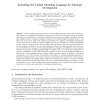130 search results - page 26 / 26 » Multi-scale modularity in complex networks |
FLAIRS
2003
13 years 7 months ago
2003
We have developed a model-based, distributed architecture that integrates diverse components in a system designed for lunar and planetary surface operations: an astronaut’s spac...
ATAL
2010
Springer
13 years 6 months ago
2010
Springer
Coordination within decentralized agent groups frequently requires reaching global consensus, but typical hierarchical approaches to reaching such decisions can be complex, slow, ...
SCP
2000
13 years 5 months ago
2000
Obtaining performance models, like Markov chains and queueing networks, for systems of significant complexity and magnitude is a difficult task that is usually tackled using human...
SOSYM
2002
13 years 5 months ago
2002
Abstract. There is rapidly growing momentum for web enabled agents that reason about and dynamically integrate the appropriate knowledge and services at run-time. The dynamic integ...
BMCBI
2007
13 years 5 months ago
2007
Background: The p53 gene family consists of the three genes p53, p63 and p73, which have polyhedral non-overlapping functions in pivotal cellular processes such as DNA synthesis a...

